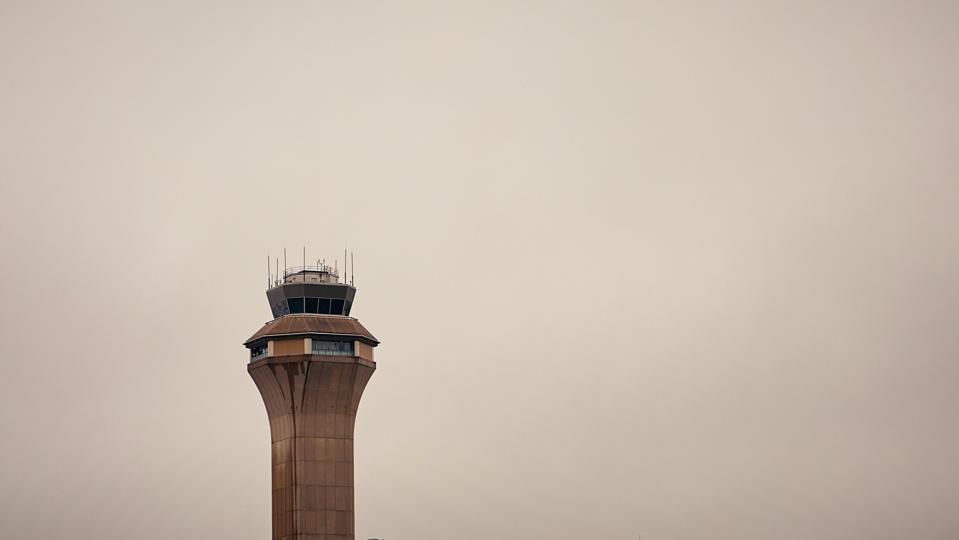Topline
Audio between air traffic controllers and pilots at Newark Airport reveals the moment when the tower lost radio contact with planes coming in to land at the busy New Jersey airport.
Key Facts
New audio from April 28 reveals how air traffic controllers temporarily lost all contact with planes approaching Newark Liberty International Airport—leaving one United Airlines pilot asking, “Approach, are you there?” according to the clip recorded by LiveATC.net and reviewed by Forbes.
A female pilot for United Airlines 1951 from New Orleans to Newark is heard radioing the control tower at least five times, repeating “go ahead for 1951,” as she sought clearance to land at the busy New Jersey airport.
After roughly 30 seconds of silence, the tower said “1951, how do you hear me?” to which the pilot responded, “I’ve got you loud and clear now, 1951.”
Less than a minute later, the tower told United flight 674, which was coming from Charleston, “we lost our radar.”
What Happened At Newark Airport On April 28?
The problem originated in Philadelphia. On Monday, April 28, air traffic controllers in a terminal radar approach control tower (TRACON) at Philadelphia International Airport responsible for separating and sequencing aircraft in and out of Newark Airport “temporarily lost radar and communications with the aircraft under their control, unable to see, hear, or talk to them,” according to a statement provided to Forbes by the National Air Traffic Controllers Association (NATCA), the union representing the country’s 10,400 air traffic controllers. Audio confirmed that the controllers lost radio contact with a United Airlines plane for approximately 30 seconds.
Did Air Traffic Controllers Really “walk Off The Job” After The Incident?
In a May 2 letter to customers, United Airlines CEO Scott Kirby wrote that “over 20% of the FAA controllers for [Newark]
walked off the job” following the incident. But the FAA clarified in a statement that “some controllers at the Philadelphia TRACON who work Newark arrivals and departures have taken time off to recover from the stress of multiple recent outages.” A spokesperson for the air traffic controllers’ union told Forbes those ATCs were put on medical leave due to trauma. “Due to the event, the controllers took absence under the Federal Employees Compensation Act. This program covers all federal employees that are physically injured or experience a traumatic event on the job,” according to the NATCA’s statement. Neither FAA nor NATCA would say how many controllers were on trauma leave.
What Caused The Loss Of Communications?
Department of Transportation Secretary Sean Duffy blamed old technology for the meltdown at Newark, saying on X that he would be “announcing a plan next week to build an all-new air traffic control system.” Forbes has not been able to verify the claim by one news outlet that the disruption was caused by faulty copper wiring.
What Does The Faa Say?
“Our antiquated air traffic control system is affecting our workforce,” the Federal Aviation Administration said in a statement. “We are working to ensure the current telecommunications equipment is more reliable in the New York area by establishing a more resilient and redundant configuration with the local exchange carriers. In addition, we are updating our automation system to improve resiliency.”
What Does This Mean For Travelers?
The shortage of controllers has caused hundreds of delayed and canceled flights at Newark Airport over the past week. But the airport is seeing far less disruption—75 delays and 47 cancellations—as of late Tuesday morning, according to FlightAware data. Since last weekend, United has cut 35 roundtrip flights per day from its Newark schedule. Delta Air Lines, which has roughly 30 daily departures from Newark, told Forbes that operational impacts for flights to the New Jersey airport have been “minimal” and that passengers encountering a cancellation at Newark are automatically rebooked to the next best available itinerary, which could include other New York City hubs at LaGuardia and JFK.
Crucial Quote
“The chaos at Newark very well could be a harbinger if issues like these aren’t fixed, and if the FAA can’t get real solutions off the ground,” Senate Minority Leader Chuck Schumer told reporters Wednesday, adding that the FAA’s plan to replace old equipment like copper wires and floppy discs also needs to be scrutinized.
Tangent
Along with outdated technology, the FAA is also challenged by a decades-long shortage of air traffic controllers. In February, Duffy unveiled a plan to “supercharge” the hiring of air traffic controllers to shave “more than four months off the old process.” But it can take nearly four years to become a certified air traffic controller, including spending several months at the FAA Academy in Oklahoma City, then completing up to three years of on-the-job experience before becoming certified, according to the FAA website.

